Lecture 4: Global Medieval Art
1/10
There's no tags or description
Looks like no tags are added yet.
Name | Mastery | Learn | Test | Matching | Spaced |
|---|
No study sessions yet.
11 Terms
Conceptions of the ‘Medieval’ (2) + Timeline
Middle of classical & early modern art
Between:
(1) The fall of the Roman Empire in 476 CE
The rise of early Modern Europe & the Renaissance (1400-1500 CE)
Clear division in time periods was a result of Renaissance scholarship
E.g. The Lives of the Most Excellent Painters, Sculptors, and Architects by Giorgio Vasari
Spoke of ‘rebirth’
Split the past into 2 separate categories: ‘antiquus’ vs. ‘vetus’
‘antiquus’: antiquity; distant past; viewed positively & revered by Vasari
‘vetus’: medieval; more immediate past; viewed as a decline
Brief timeline (500-1500 CE):
Early Medieval art
Carolingian art
Byzantine art
High middle ages
Romanesque art
Gothic art
Duecento (early proto-Renaissance), trecento (transitional period between the medieval era and the Renaissance), quattrocento (early Renaissance) art
Problems w/ the study of Medieval art
Western lens
Sole focus on Western Europe & Eurasia
In reality, the development of Medieval art was influenced by a broad range of cultures, including non-European ones
Issues viewed in black and white
Discussion of connections vs. differences in Medieval art as if they are strictly separate & contrasting qualities
Project rigidity & linearity on its development (direct ‘evolution’ from bad art → good art)
Focus on canonical ‘masters’
Spotlight trained on exceptional artistic personalities
Partially because (1) many art historians were also collectors and (2) works by ‘famous’ artists yielded greater financial returns
DESPITE the fact that most medieval art was anonymous
German art historian Hans Belting: ‘the year of the artist really only began in the Renaissance period’
BUT this theory artificially separates the medieval from the Renaissance = might not always be useful
Much of medieval art is associated w/ religion (Christianity)
BUT this is because Church treasuries excelled in preserving artworks
May have led to overrepresentation of religious art from the medieval era
Some existing evidence of medieval art for non-religious/non-serious purposes
Comedic/silly objects seemingly made for fun (e.g. caricature of a Viking (beserker) as the Rook piece in chess)
What is globalisation?
Traditional narrative: started w/ Christopher Columbus
Landed in the Caribbean in 1492
Associates globalisation w/:
Transatlantic maritime expansion
Industrialisation
Slave trade
BUT some scholars argue that globalisation already existed much earlier
E.g. evidence of international trade & cultural influences
E.g. The Year 1000 by historian Valerie Hansen
Proposes that globalisation began around this time
Due to important advancements in technology & cartography
E.g. Al-Idrisi’s world map (1152) - includes latitudes & longitudes, coordinates of various places in the world
Islamic map w/ Mecca as the centre
E.g. Islamic polymath Abu Rayhan al-Biruni recognised that the Earth is a sphere (1000)
Difficult to define
What criterion should we use to measure:
Distances of connections?
Number of networks?
Extent of differences between regions?
To what extent should these criterion be measured? (e.g how far? how many differences?)
Difficulties & Problems w/ the study of Global Medieval art
Difficulty w/ defining globalisation
What criterion should we use to measure:
Distances of connections?
Number of networks?
Extent of differences between regions?
To what extent should these criterion be measured? (e.g how far? how many differences?)
Limitations in scope of study
(1) Temporal spotlighting
Focus on the Mongol period & 14th century (classical period)
(2) Eurocentrism
(3) Methodological limitations
Scholars tend to focus on either:
(A) Interconnectivity (everything is connected)
(B) Differences
Unnecessarily polarised/discrete
Can we combine these approaches to give a more nuanced picture of globalisation?
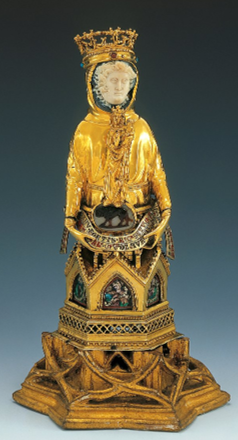
Golden figure of King David (ca. 1280 & ca. 1320)
Reliquary
Holding a scroll w/ an inscription: tells you it’s King David
An Old Testament ancestor of Christ
Holding a mini figure of the Virgin Mary & the Christ child
Golden parts were made in the 13th & early 14th century
Face is a separate piece from the 1st century CE
Antique gem of a Medusa head
Reused & incorporated to form this late medieval ensemble
Spolia: derived from the Latin word for "spoils" or "booty”; involves repurposing art and architectural elements from previous constructions or demolished structures
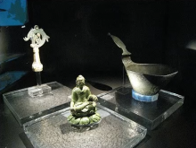
Helgö Hoard
Historical context
Norsemen/Vikings
A hoard is an accumulation of objects
Helgö Hoard was a ship burial
Found in Lake Malaren, west of Stockholm
Description
Included objects from other countries/continents and time periods
Objects come from the Silk Road, the Muslim world, and Europe across a range of time periods
E.g. Egyptian ladle
E.g. Buddha statuette from Modern day Pakistan (~500 CE)
Chess (9th-15th century)
Historical context
Originated in India
Later spread East & West via the Silk Road
Originated in the 6th century
By 1000 CE, was a popular game in Africa, Asia, & Europe
Played by people across social strata
Evidence:
Many medieval chess sets which are relatively unadorned & produced w/ low quality survive
Chess pieces made of varying materials (ivory vs. wood)
Many variations of rules & ways to play: There was never a single game of ‘medieval chess’
Chess has rarely been studied in art history: considered a decorative/functional art
Benefits of studying the development of chess: helps detach from a Eurocentric perspective as its history is entangled w/ so many regions & periods
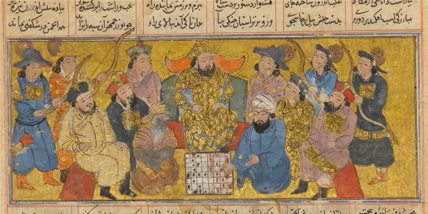
Depiction of chess in The Shahnameh (Book of Kings)
Historical context
Persian epic (c. 1300-30 CE)
14th century image of a 6th century event
Narrative:
In order to avoid paying tribute to the Sasanians, the Rajah of Hind (India) sent an envoy challenging the Iranian ruler to figure out how this game was played
Unfortunately, the clever vizier Buzurjmihr secured the tribute for his (Sasanian) king by solving the problem
Visual analysis
Clothing:
Iranians dressed in Mongol costume
Erudite vizier Buzurjmihr wears 14th century Persian-style tunic and turban (fashion of contemporary audience)
Indian envoy
Dark-skinned man
Wearing baggy clothes and a loose turban
All alone among the Iranians as if underscoring his defeat at the game
Significance of colour:
NOT always black & white pieces
E.g. E.g. black & red was quite popular for Islamic chess sets
Chess is ultimately a game of war: colours are crucial in differentiating armies
Interpretation
Centrality of chess in a cross-cultural interaction
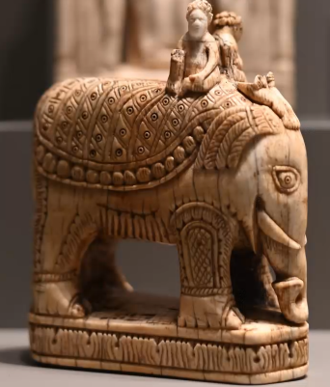
Elephant chess figure (bishop) from the ‘Charlemagne set’ (1080s)
Provenance
Charlemagne’s personal chess set
Was the Holy Roman Emperor in the early 9th century
Luxury chess set fit for an emperor: huge, elaborately-carved pieces
Chess set was carved in 11th/12th century Southern Italy
Elephant ivory
Possibly from Africa or India
Visual analysis
Iconography of the elephant
Interpretation
Evidence of international trade
Ivory: sourced from Africa/India, carved in southern Italy, ended up in Paris
Adaptations of chess piece designs as a result of cultural influence
Chess piece designs were believed to have been influenced by the late antique Indian army
4 main constituents:
(1) Infantry
(2) Calvary
(3) Chariots
(4) Elephants
In the 12th century, elephant pieces —> bishops
Formal resemblance:
Elephants have 2 tusks
Episcopal bishops wear hats that have 2 pointy ends (mitre)
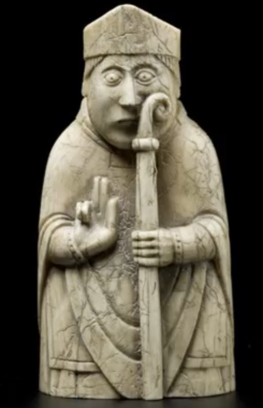
Bishop chess piece from the Lewis set (c. 1150-1200)
Provenance
Part of the Lewis chess set
Part of a large hoard buried on the Isle of Lewis, Scotland
All pieces carved to resemble human pieces EXCEPT pawns
Made from walrus tusk & bears’ teeth
Unusual material
Walrus ivory was traded through Scandinavian ports
Quite hard to work with in comparison to elephant tusk
Walrus tusk is thinner & has a larger cavity
Less of the shiny, outer layer (which is more decorative)
= requires much skill to work w/
Carved in 12th century Norway
Evidenced by elaborate carvings on the back
Resemble carvings in the Nidaros cathedral (Norway)
Visual analysis
Appearance of new imagery
In the 12th century, elephant pieces → bishops
Formal resemblance:
Elephants have 2 tusks
Episcopal bishops wear hats that have 2 pointy ends (mitre)
Interpretation
Evidence of international trade
Walrus tusk traded through Scandinavian ports
Adaptations of chess piece designs as a result of cultural influence
Christina Normore, “Editor’s Introduction: A World within Worlds? Reassessing the Global Turn in Medieval Art History”
Interdisciplinary conference in 2014
Of new work in the fields of Byzantine, Islamic, and European medieval art history
Stated aim: to “explore the disciplinary and interdisciplinary situation and stakes of the field.”
Deliberate attempt to select scholars w/ a variety of expertise
Early career scholars, defined as those at the postdoctoral, assistant professor, or recently tenured level
Who all shared a sustained research interest in global interactions
BUT limitations remained (e.g. the absence of specialists in Indian Ocean and Baltic studies)
Vs. higher representation of scholars specialising in the Mediterranean basin & Silk Roads
Reflective of the priorities of academic art history in North America at the time (favoured these 2 exchange routes as synecdoches for the larger problem of cross-cultural interaction)
Selective funding & training of art historians
= uneven levels of representation even within supposedly global studies of art history
Ongoing struggle between a gradual attitudinal shift towards the pursuit of globality, and the existing limitations inherent to the art historical discipline (e.g. dependence of research & education on selective funding)